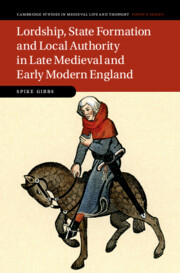Appendix 2 Identifying Individuals
Much of the statistical analysis of officeholding in chapters 2, 5 and 6 relies on identifying individuals holding office within the same set of court rolls across time or between different sets of records. Identifying individuals within manorial records is not straightforward, owing to the difficulties posed either by the same individual being recorded under different surnames or by two individuals sharing the same name.Footnote 1 Fortunately, the first problem is confined largely to the pre-Black Death period, with surnames generally becoming more fixed in the fifteenth and sixteenth centuries.Footnote 2 The second problem is more pertinent, especially if one assumes that families with shared surnames often provided multiple officers. Fortunately, court clerks did try to distinguish between individuals by providing descriptive additions to names.Footnote 3 Devices used as ‘secondary identifiers’ include occupational identifiers (such as John Buk (active 1416–50) and John Buk Bateman (active 1423–38); locative identifiers (such as William Rowley of Wyke (active 1508–40) and William Rowley of Newton (active 1524–41); and most ubiquitously, junior and senior (such as John Atte Lane snr (active 1462–72) and John Atte Lane jnr (active 1468–88).Footnote 4
The methodology to identify individuals adopted a two-stage process. Firstly, all names of officers were extracted and standardised to account for various spellings but with any secondary identifiers retained. Secondly, names were turned into individuals identified by a unique ‘officer number’. This last process was performed chronologically and worked on the assumption that any names, either unmodified or with the same secondary identifiers, appearing within a space of five years denoted the same individual. This rule was suspended for long breaks of more than five years in the record, for which it was assumed that a name appearing in the final year of records before the break, and the first year of records after the break, could potentially be the same individual, subject to checks explored below. Individuals with the same name and different secondary identifiers were assumed to be different individuals when they appeared in the same session. Occasionally, one individual appears to have initially appeared with their name unmodified, then appeared with a secondary identifier, and then later appeared again without modification. If no session could be found where both the unmodified and modified name served in office simultaneously, it was assumed that this was the same individual, both with and without secondary modifier. The same five-year rule was applied when linking individuals in court rolls with those in other records.
The most difficult issue arose with the appending of the terms ‘senior’ and ‘junior’ to individuals with the same name who served simultaneously, as such relational identifiers changed over time. Thus, at Worfield one man named John Baker served 1548–79. However, from 1580 onwards there are two John Bakers, referred to as senior and junior. However, from 1585 until 1600 the designators again disappear, with a single John Baker appearing.Footnote 5 In these cases, it has been assumed that emergence of the use of snr and jnr as secondary identifiers refers to a period of crossover between an older and younger individual with the same name, while the disappearance of identifiers represents the withdrawal, most likely through death, of the senior, and thus older individual. So in this scenario, it is assumed John Baker I served 1548–84, while John Baker II served 1580–1600. While undoubtedly it is possible that a senior man may have outlived a younger individual, in the absence of more concrete information this is the safest assumption.
A final check was performed by examining the length of officeholding career of individuals. A sixty-five year maximum length was assumed, with any apparently longer careers assumed to be the conflation of two men. In these cases, two individuals were created by splitting the names at the longest gap between appearances of the name. Throughout all the rules outlined above, each name was treated on a case-by-case basis, especially if there was other evidence to help distinguish individuals, such as the clerk using two surnames simultaneously to describe a single individual.
1 Briggs, Credit, 229; Razi, Life, Marriage and Death, 11–12.
2 Razi, Life, Marriage and Death, 11; J.M. Bennett, ‘Spouses, siblings and surnames: reconstructing families from medieval village court rolls’, JBS, 23 (1983), 26–46, at 37–9.
3 Bennett, ‘Spouses, siblings’, 38–9; Briggs, Credit, 230.
4 CUL, EDR, c11/2/5–6; SAC, p314/w/1/1/503–661; kcar/6/2/87/1/1/hor/37, kcar/6/2/87/1/1/hor/39–41.
5 SA, p314/w/1/1/676–836.



